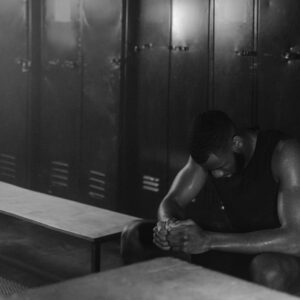Contents
- 1. Musculoskeletal Injuries
- 2. Joint Stress and Long-Term Wear
- 3. Fainting (Exercise-Induced Syncope)
- 4. Spinal Disc Injuries
- 5. Central Nervous System (CNS) Fatigue
- 6. Hormonal and Recovery Disruption
- 7. Technique Breakdown and Movement Compensations
- 8. Mental Health and Ego Lifting Pressure
- Warning Signs You’re Lifting Too Much Weight
- How to Prevent Injury When Lifting Heavy
- Conclusion
Resistance training is essential for building strength, increasing muscle mass, and improving overall health. However, when individuals lift more weight than they can safely handle, the consequences can outweigh the benefits. Whether due to ego lifting, lack of supervision, or improper progression, lifting excessively heavy loads can result in acute injuries, chronic joint problems, and central nervous system fatigue, and even fainting (syncope).
This article breaks down the harmful effects of lifting too much weight and provides practical strategies for safe and effective strength training. Below, we break down the most common physiological consequences of overloading and what you can do to protect yourself or your clients.
1. Musculoskeletal Injuries
Lifting too much weight places overwhelming stress on muscles, tendons, and ligaments. This can lead to muscle strains, ligament sprains, tendon inflammation, or even full ruptures. These injuries often occur when a lifter attempts a weight they cannot control or perform with proper form, especially in multi-joint movements like the bench press, squat, or deadlift.
Common Injuries:
- Muscle strains and tears
- Ligament sprains
- Tendonitis or tendon rupture
- Herniated discs
- Joint dislocations or cartilage damage
Options to Avoid Injury
- If in doubt, choose control over ego: better to lift 5–10% lighter with excellent form.
- Begin each session with a thorough warm-up using lighter weights and mobility work.
- Use progressive overload—add weight in small increments only when form remains consistent.
- Have a qualified coach assess your lifting technique.
Research Insight: A 2018 review in BMJ Open Sport & Exercise Medicine found that improper load selection and poor form were among the top causes of injuries in recreational lifters.
2. Joint Stress and Long-Term Wear
When joints are overloaded repeatedly without sufficient recovery, the cartilage that cushions them begins to wear down. The shoulders, knees, hips, and spine are particularly vulnerable when the load exceeds what the stabilizing muscles and ligaments can support.
Common Injuries:
- Chronic shoulder or knee pain
- Cartilage degradation
- Osteoarthritis
- Meniscus or labral tears
Options to Protect Joints
- Rotate heavy lifting phases with deload weeks or mobility-focused training.
- Don’t max out every session—alternate intensity levels across the week.
- Use proper equipment (like lifting shoes, wrist wraps, knee sleeves) when appropriate.
- Include unilateral and corrective exercises to balance joint loading.
Repetitive overloading may accelerate joint degeneration, especially in older adults or those with poor mobility or alignment.
3. Fainting (Exercise-Induced Syncope)
Syncope (fainting) during or after lifting heavy weights is not uncommon, and it can occur due to several interrelated factors:
- The Valsalva maneuver (holding your breath), which restricts blood flow and causes a sudden drop in blood pressure.
- Orthostatic hypotension, when blood pools in the legs and deprives the brain of oxygen.
- Low blood sugar or dehydration, especially in fasted or underfed states.
- Overexertion or vagal nerve activation, particularly in highly stressed or deconditioned lifters.
Warning Signs Before Fainting:
- Tunnel vision
- Sudden nausea or clammy skin
- Weakness or shakiness
- Dizziness after locking out a lift
- A sense of “going black” or hearing loss
Options to Prevent Fainting
- Breathe steadily and avoid prolonged bracing unless necessary for maximal lifts.
- Never skip meals before intense training—eat a light, balanced pre-workout meal.
- Stay well-hydrated and take rest breaks as needed.
- Ease into standing movements after seated or lying exercises (e.g., leg press).
McCullough et al. (2016) emphasized that syncope during resistance training is more common among those new to heavy lifting or under high mental or physical strain.
4. Spinal Disc Injuries
Lifting heavy with poor posture or weak core engagement places enormous compressive forces on the spine. Over time, this can cause spinal disc injuries such as bulges, herniations, or nerve impingement (e.g., sciatica). These injuries may cause sharp pain, numbness, or mobility limitations.
Options to Protect the Spine
- Use proper spinal alignment and bracing techniques—neutral spine is critical.
- Strengthen the deep core muscles (e.g., transverse abdominis) with targeted work.
- Avoid heavy barbell loading until you’ve mastered foundational bodyweight and dumbbell lifts.
- When in doubt, regress to a safer variation (e.g., trap bar instead of straight bar deadlifts).
Movements like the deadlift, barbell row, or back squat—if performed with poor core engagement—can transmit excessive pressure to the lumbar spine.
5. Central Nervous System (CNS) Fatigue
Lifting too much, too often—especially near max effort—can overwhelm the CNS. Unlike muscle soreness, CNS fatigue is systemic: it causes mental fog, reduced coordination, sleep disruption, and slower reaction times. Without rest, this leads to overtraining syndrome.
Options to Manage CNS Fatigue
- Use structured programming with planned deloads every 4–6 weeks.
- Vary your training loads (e.g., heavy, moderate, and light days) across the week.
- Monitor signs of CNS stress like insomnia, irritability, or unmotivated sessions.
- Prioritize recovery with sleep, nutrition, and active rest days.
CNS fatigue impairs force output and increases the risk of technical breakdown, which often precedes injury.
Note: CNS fatigue differs from muscle soreness—it’s more neurological and affects mood, motivation, and performance.
6. Hormonal and Recovery Disruption
Excessively heavy lifting with inadequate recovery can raise cortisol, suppress testosterone and growth hormone, and disturb insulin sensitivity. These hormonal imbalances slow muscle growth, impair recovery, and increase fat retention.
Options to Support Hormonal Balance
- Avoid training to failure in every session—leave 1–2 reps in reserve.
- Ensure proper nutrition, particularly post-workout protein and carbs.
- Get at least 7–9 hours of quality sleep.
- Don’t train intensely every day—recovery is when growth happens.
According to the National Strength and Conditioning Association (NSCA), advanced athletes should follow planned intensity cycles to avoid hormonal and metabolic disturbances.
7. Technique Breakdown and Movement Compensations
When loads exceed what a lifter can control, their form often breaks down, leading to:
- Rounded backs in deadlifts
- Excessive forward knee travel in squats
- Overarching the lower back during overhead lifts
- Jerky bar path and unsafe mechanics
Poor technique under heavy loads not only reduces the effectiveness of the lift but also significantly increases injury risk.
8. Mental Health and Ego Lifting Pressure
Ego lifting—choosing weight based on pride or pressure—can increase anxiety, reduce confidence, and erode motivation. Social media comparison, gym culture, or competition can drive lifters to push loads their body isn’t ready for.
Options for Mental Wellness
- Set performance-based goals (form, reps, mobility) rather than weight alone.
- Celebrate consistency and technique just as much as PRs.
- Take breaks from external pressure by training solo or off social media.
- Seek mentorship or coaching that values longevity over max lifts.
A performance-focused mindset is valuable, but prioritizing form and progress over numbers is key for long-term health.
Warning Signs You’re Lifting Too Much Weight
- You’re consistently using momentum or jerky movements
- Your form deteriorates quickly during sets
- You experience lingering joint pain or soreness
- You’re unable to complete reps with control
- You frequently need spotters to lift off or re-rack
- You dread your workouts or feel excessively fatigued
How to Prevent Injury When Lifting Heavy
- Use proper technique and progress gradually
- Follow periodized programming (deload weeks included)
- Warm up properly with dynamic movements
- Focus on controlled tempo and full range of motion
- Train with a spotter or under professional supervision
- Listen to your body—if it hurts, don’t push through
Conclusion
While lifting heavy weights is effective for building strength and muscle, lifting beyond your limits without control, structure, or technique leads to avoidable injuries and setbacks. Strength training should be about longevity and progression, not short-term ego lifts. With smart programming, proper technique, and attention to recovery, you can build a resilient, strong body—without breaking it.
References
- Keogh JW, Winwood PW. The epidemiology of injuries across sports disciplines: A review of the literature. Sports Medicine. 2017;47(3):469–490.
- Aasa U, Svartholm I, Andersson F, Berglund L. Injuries among weightlifters and powerlifters: A systematic review. BMJ Open Sport & Exercise Medicine. 2017;3(1):e000213.
- Schoenfeld BJ. The mechanisms of muscle hypertrophy and their application to resistance training. Journal of Strength and Conditioning Research. 2010;24(10):2857–2872.
- NSCA (National Strength and Conditioning Association). Essentials of Strength Training and Conditioning, 4th Edition. Human Kinetics; 2016.



